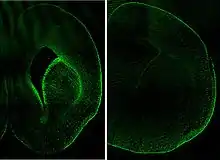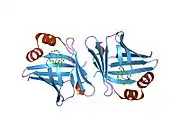FABP7
Fatty acid binding protein 7, brain (FABP7; also brain lipid binding protein, BLBP), is a human gene.[5]
Function
The protein encoded by this gene is a brain fatty acid binding protein. Fatty acid binding proteins (FABPs) are a family of small, highly conserved, cytoplasmic proteins that bind long-chain fatty acids and other hydrophobic ligands. FABPs are thought to play roles in fatty acid uptake, transport, and metabolism.[5]
FABP7 is expressed, during development, in radial glia by the activation of Notch receptors.[6] Reelin was shown to induce FABP7 expression in neural progenitor cells via Notch-1 activation.[7]
According to one study, FABP7 binds DHA with the highest affinity among all of the FABPs.[8]

Role in pathology
FABP7 maps onto human chromosome 6q22.31, a schizophrenia linkage region corroborated by a meta-analysis.[9]
As of 2008, two studies have been conducted into FABP7 as a possible risk gene for schizophrenia,[10] with one, that tested for only one SNP, showing negative[11] and another, with seven SNPs,[12] a positive result. The effect of the gene in the latter study was stronger in males. This study also linked FABP7 variation to weak prepulse inhibition in mice; deficit in PPI is an endophenotypic trait observed in schizophrenia patients and their relatives.
References
- GRCh38: Ensembl release 89: ENSG00000164434 - Ensembl, May 2017
- GRCm38: Ensembl release 89: ENSMUSG00000019874 - Ensembl, May 2017
- "Human PubMed Reference:". National Center for Biotechnology Information, U.S. National Library of Medicine.
- "Mouse PubMed Reference:". National Center for Biotechnology Information, U.S. National Library of Medicine.
- "Entrez Gene: FABP7 fatty acid binding protein 7, brain".
- Anthony TE, Mason HA, Gridley T, Fishell G, Heintz N (May 2005). "Brain lipid-binding protein is a direct target of Notch signaling in radial glial cells". Genes & Development. 19 (9): 1028–33. doi:10.1101/gad.1302105. PMC 1091737. PMID 15879553.
- Keilani S, Sugaya K (July 2008). "Reelin induces a radial glial phenotype in human neural progenitor cells by activation of Notch-1". BMC Developmental Biology. 8 (1): 69. doi:10.1186/1471-213X-8-69. PMC 2447831. PMID 18593473.
- Xu LZ, Sánchez R, Sali A, Heintz N (Oct 1996). "Ligand specificity of brain lipid-binding protein". The Journal of Biological Chemistry. 271 (40): 24711–9. doi:10.1074/jbc.271.40.24711. PMID 8798739.
- Lewis CM, Levinson DF, Wise LH, DeLisi LE, Straub RE, Hovatta I, Williams NM, Schwab SG, Pulver AE, Faraone SV, Brzustowicz LM, Kaufmann CA, Garver DL, Gurling HM, Lindholm E, Coon H, Moises HW, Byerley W, Shaw SH, Mesen A, Sherrington R, O'Neill FA, Walsh D, Kendler KS, Ekelund J, Paunio T, Lönnqvist J, Peltonen L, O'Donovan MC, Owen MJ, Wildenauer DB, Maier W, Nestadt G, Blouin JL, Antonarakis SE, Mowry BJ, Silverman JM, Crowe RR, Cloninger CR, Tsuang MT, Malaspina D, Harkavy-Friedman JM, Svrakic DM, Bassett AS, Holcomb J, Kalsi G, McQuillin A, Brynjolfson J, Sigmundsson T, Petursson H, Jazin E, Zoëga T, Helgason T (Jul 2003). "Genome scan meta-analysis of schizophrenia and bipolar disorder, part II: Schizophrenia". American Journal of Human Genetics. 73 (1): 34–48. doi:10.1086/376549. PMC 1180588. PMID 12802786.
- Gene Overview of All Published Schizophrenia-Association Studies for FABP7 - SZGene database at Schizophrenia Research Forum website.
- Jungerius BJ, Hoogendoorn ML, Bakker SC, Van't Slot R, Bardoel AF, Ophoff RA, Wijmenga C, Kahn RS, Sinke RJ (Nov 2008). "An association screen of myelin-related genes implicates the chromosome 22q11 PIK4CA gene in schizophrenia". Molecular Psychiatry. 13 (11): 1060–8. doi:10.1038/sj.mp.4002080. PMID 17893707.
- Watanabe A, Toyota T, Owada Y, Hayashi T, Iwayama Y, Matsumata M, Ishitsuka Y, Nakaya A, Maekawa M, Ohnishi T, Arai R, Sakurai K, Yamada K, Kondo H, Hashimoto K, Osumi N, Yoshikawa T (Nov 2007). "Fabp7 maps to a quantitative trait locus for a schizophrenia endophenotype". PLOS Biology. 5 (11): e297. doi:10.1371/journal.pbio.0050297. PMC 2071943. PMID 18001149.
Further reading
- Börchers T, Hohoff C, Buhlmann C, Spener F (Jul 1997). "Heart-type fatty acid binding protein - involvement in growth inhibition and differentiation". Prostaglandins, Leukotrienes, and Essential Fatty Acids. 57 (1): 77–84. doi:10.1016/S0952-3278(97)90496-8. PMID 9250612.
- Xu LZ, Sánchez R, Sali A, Heintz N (Oct 1996). "Ligand specificity of brain lipid-binding protein". The Journal of Biological Chemistry. 271 (40): 24711–9. doi:10.1074/jbc.271.40.24711. PMID 8798739.
- Young JK, Baker JH, Muller T (Mar 1996). "Immunoreactivity for brain-fatty acid binding protein in gomori-positive astrocytes". Glia. 16 (3): 218–26. doi:10.1002/(SICI)1098-1136(199603)16:3<218::AID-GLIA4>3.0.CO;2-Y. PMID 8833192.
- Shi YE, Ni J, Xiao G, Liu YE, Fuchs A, Yu G, Su J, Cosgrove JM, Xing L, Zhang M, Li J, Aggarwal BB, Meager A, Gentz R (Aug 1997). "Antitumor activity of the novel human breast cancer growth inhibitor, mammary-derived growth inhibitor-related gene, MRG". Cancer Research. 57 (15): 3084–91. PMID 9242429.
- Shimizu F, Watanabe TK, Shinomiya H, Nakamura Y, Fujiwara T (Oct 1997). "Isolation and expression of a cDNA for human brain fatty acid-binding protein (B-FABP)". Biochimica et Biophysica Acta (BBA) - Gene Structure and Expression. 1354 (1): 24–8. doi:10.1016/S0167-4781(97)00115-2. PMID 9375786.
- Godbout R, Bisgrove DA, Shkolny D, Day RS (Apr 1998). "Correlation of B-FABP and GFAP expression in malignant glioma". Oncogene. 16 (15): 1955–62. doi:10.1038/sj.onc.1201740. PMID 9591779.
- Pu L, Igbavboa U, Wood WG, Roths JB, Kier AB, Spener F, Schroeder F (Aug 1999). "Expression of fatty acid binding proteins is altered in aged mouse brain". Molecular and Cellular Biochemistry. 198 (1–2): 69–78. doi:10.1023/A:1006946027619. PMID 10497880. S2CID 6180992.
- Balendiran GK, Schnutgen F, Scapin G, Borchers T, Xhong N, Lim K, Godbout R, Spener F, Sacchettini JC (Sep 2000). "Crystal structure and thermodynamic analysis of human brain fatty acid-binding protein". The Journal of Biological Chemistry. 275 (35): 27045–54. doi:10.1074/jbc.M003001200. PMID 10854433.
- Rademacher M, Zimmerman AW, Rüterjans H, Veerkamp JH, Lücke C (Oct 2002). "Solution structure of fatty acid-binding protein from human brain". Molecular and Cellular Biochemistry. 239 (1–2): 61–8. doi:10.1023/A:1020566909213. PMID 12479569. S2CID 24296178.
- Miller SJ, Li H, Rizvi TA, Huang Y, Johansson G, Bowersock J, Sidani A, Vitullo J, Vogel K, Parysek LM, DeClue JE, Ratner N (Mar 2003). "Brain lipid binding protein in axon-Schwann cell interactions and peripheral nerve tumorigenesis". Molecular and Cellular Biology. 23 (6): 2213–24. doi:10.1128/MCB.23.6.2213-2224.2003. PMC 149461. PMID 12612091.
- Sánchez-Font MF, Bosch-Comas A, Gonzàlez-Duarte R, Marfany G (Jun 2003). "Overexpression of FABP7 in Down syndrome fetal brains is associated with PKNOX1 gene-dosage imbalance". Nucleic Acids Research. 31 (11): 2769–77. doi:10.1093/nar/gkg396. PMC 156729. PMID 12771203.
- Wang M, Liu YE, Goldberg ID, Shi YE (Nov 2003). "Induction of mammary gland differentiation in transgenic mice by the fatty acid-binding protein MRG". The Journal of Biological Chemistry. 278 (47): 47319–25. doi:10.1074/jbc.M308131200. PMID 12975368.
- Liang Y, Diehn M, Watson N, Bollen AW, Aldape KD, Nicholas MK, Lamborn KR, Berger MS, Botstein D, Brown PO, Israel MA (Apr 2005). "Gene expression profiling reveals molecularly and clinically distinct subtypes of glioblastoma multiforme". Proceedings of the National Academy of Sciences of the United States of America. 102 (16): 5814–9. Bibcode:2005PNAS..102.5814L. doi:10.1073/pnas.0402870102. PMC 556127. PMID 15827123.
- Liang Y, Bollen AW, Aldape KD, Gupta N (2006). "Nuclear FABP7 immunoreactivity is preferentially expressed in infiltrative glioma and is associated with poor prognosis in EGFR-overexpressing glioblastoma". BMC Cancer. 6: 97. doi:10.1186/1471-2407-6-97. PMC 1479358. PMID 16623952.
- Kaloshi G, Mokhtari K, Carpentier C, Taillibert S, Lejeune J, Marie Y, Delattre JY, Godbout R, Sanson M (Sep 2007). "FABP7 expression in glioblastomas: relation to prognosis, invasion and EGFR status". Journal of Neuro-Oncology. 84 (3): 245–8. doi:10.1007/s11060-007-9377-4. PMID 17415524. S2CID 23880935.
- Takaoka N, Takayama T, Teratani T, Sugiyama T, Mugiya S, Ozono S (2011). "Analysis of the regulation of fatty acid binding protein 7 expression in human renal carcinoma cell lines". BMC Molecular Biology. 12 (1): 31. doi:10.1186/1471-2199-12-31. PMC 3162894. PMID 21771320.
External links
- Schizophrenia, Startled Response & Fabp7: Future Dietary Changes for At-Risk Mothers? Schizophrenia Daily News Blog, 2007-11-07
- Gross L (2007). "A Candidate Gene for a Biological Marker of Schizophrenia in Mice". PLOS Biology. 5 (11): e320. doi:10.1371/journal.pbio.0050320. PMC 2071941. PMID 20076655. - a synopsis for the general audience.
- Overview of all the structural information available in the PDB for UniProt: O15540 (Fatty acid-binding protein, brain) at the PDBe-KB.










